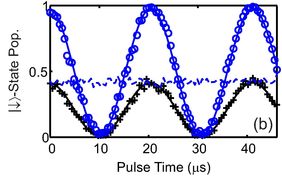B Hemmerling1,4,5, F Gebert1, Y Wan1,3 and P O Schmidt1,2
1 QUEST Institute for Experimental Quantum Metrology, Physikalisch-Technische Bundesanstalt, 38116 Braunschweig, Germany
2 Institut für Quantenoptik, Leibniz Universität Hannover, 30167 Hannover, Germany
3 Braunschweig International Graduate School of Metrology, Technische Universität Braunschweig, 38106 Braunschweig, Germany
5 Present address: Department of Physics, Harvard University, Cambridge, MA 02138, USA.
We studied a novel method for quantum state discrimination in a
two-level system which is robust against fluctuations in experimental
parameters. The new protocol incorporates anti-correlations between two
sub-sequent state detection events and acts as a post-selective
statistical filter on the detection outcome. This concept introduces a
certain symmetry in the detection process and significantly reduces the
bias towards one of the states which is a known drawback in
conventionally used techniques. While being generally applicable to many
system, we implemented this type of detection in a two-level system with
a single Mg^{25} ion. A detailed study, including a theoretical analysis
with comparisons to other schemes, can be found here [1].
Conventional detection methods rely on the state-dependent fluorescence
to distinguish between two quantum states in an atom. Typically, one of
the states is part of a cycling transition, i.e. a high number of
photons is scattered, whereas the second state remains (almost) dark
during the detection. Setting a threshold in the photon number and
assigning all events with photon counts above the chosen threshold to
one of the states and the remaining events to the second state, defines
the usual state discrimination protocol. While this method works
extremely well if the photon distributions of both states are well
distinguishable, a bias is introduced if only a low number of photons is
detected and both distributions start to overlap - even if the detection
takes place at the shot-noise level. This introduces an unambiguity in
the assignment of the states. In our novel approach, the effect is
overcome by applying a coherent spin-flip after the detection event and
adding a second detection event at the end. The new protocol uses the
correlation between both events to apply a statistical filter which
drops all unambiguous events. Applying this scheme, we were able to
improve the contrast of a Rabi oscillation measurement from 41% (Fig1:
black line) to 96% (Fig1: blue line). We were further able to
demonstrate that the filtering algorithm makes the detection process
much less sensitive towards any changes in the environment, as e.g. the
power of the detection laser, which makes this approach a rather
interesting tool for other precision measurement experiments which rely
on an exact quantum state determination.
Reference:  New J. Phys.14 023043 (2012)
New J. Phys.14 023043 (2012)

